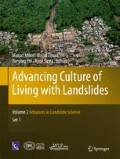Abstract
 Confined or channelized debris flow is one of the most powerful processes for transporting solid materials along the mountain torrent. It is defined as a type of mass movement that involves water-charged, predominantly coarse materials flowing rapidly down along a steep confined, pre-existed channel. Development of debris flow is broadly characterized by initiation, transportation, and deposition, depending on channel gradient, and size and gradation of solid mixture. In order to design debris flow control structure, exact measurement of velocity and corresponding impact force are required. Therefore, debris flow flume has been designed in this study to experimentally examine the flow characteristics of debris flow. A 200 mm (W) × 300 mm (H) × 2000 mm (L) flume has been used to conduct the experiments with a flume slope of 25°, 30°, 35°, 40°. Velocity of debris flow was estimated by image analysis of photographs, and runout length and width were measured using grids on deposition pan. Two types of debris mixture have defined, based on the portion of clay, sand, and gravel materials. Experiments showed that velocities of debris flow strongly related to flume slope, ranging 1.5–2.5 m/s. Runout length and width were affected by the flume slope and debris flow composition.
Confined or channelized debris flow is one of the most powerful processes for transporting solid materials along the mountain torrent. It is defined as a type of mass movement that involves water-charged, predominantly coarse materials flowing rapidly down along a steep confined, pre-existed channel. Development of debris flow is broadly characterized by initiation, transportation, and deposition, depending on channel gradient, and size and gradation of solid mixture. In order to design debris flow control structure, exact measurement of velocity and corresponding impact force are required. Therefore, debris flow flume has been designed in this study to experimentally examine the flow characteristics of debris flow. A 200 mm (W) × 300 mm (H) × 2000 mm (L) flume has been used to conduct the experiments with a flume slope of 25°, 30°, 35°, 40°. Velocity of debris flow was estimated by image analysis of photographs, and runout length and width were measured using grids on deposition pan. Two types of debris mixture have defined, based on the portion of clay, sand, and gravel materials. Experiments showed that velocities of debris flow strongly related to flume slope, ranging 1.5–2.5 m/s. Runout length and width were affected by the flume slope and debris flow composition.
Access this chapter
Tax calculation will be finalised at checkout
Purchases are for personal use only
References
Coussot P, Meunier M (1996) Recognition, classification and mechanical description of debris flows. Earth Sci Rev 40:209–227
D’Agostino V, Cesca M, Marchi L (2010) Field and laboratory investigations of runout distances of debris flows in the Dolomites (Eastern Italian Alps). Geomorphology 115:294–304
Davies TR (1990) Debris-flow surges-experimental simulation. J Hydrol (NZ) 29:18–46
Fairfield G (2011) Assessing the dynamic influences of slope angle and sediment composition on debris flow behaviour: an experimental approach. Ph.D. thesis, Durham University, UK
Hungr O, Evans S, Bovis M, Hutchinson J (2001) A review of the classification of landslides of the flow type. Environ Eng Geosci 7:221–238
Iverson RM (1997) The physics of debris flows. Rev Geophys 35:245–296
Iverson RM (2015) Scaling and design of landslide and debris-flow experiments. Geomorphology 244:9–20
Iverson RM, Logan M, LaHusen RG, Berti M (2010) The perfect debris flow? aggregated results from 28 large-scale experiments. J Geophys Res Earth Surf 115(F3)
Jun K-J, Yune C-Y (2015) Analysis of slope hazard triggering factors through field investigation in Korea over the past four years. J Korean Geotech Soc 31(5):47–58 (in Korean)
Moriguchi S, Borja R, Yashima A, Sawada K (2009) Estimating the impact force generated by granular flow on a rigid obstruction. Acta Geotech 4:57–71
Parsons JD, Whipple KX, Simoni A (2001) Experimental study of the grain-flow, fluid-mud transition in debris flows. J Geol 109(4):427–447
Pierson TC, Costa JE (1987) A rheologic classification of subaerial sediment-water flows. Rev Eng Geol 7:1–12
Rickenmann D, Zimmermann M (1993) The 1987 debris flows in Switzerland: documentation and analysis. Geomorphology 8:175–189
Scheidl C, Chiari M, Kaitna R, Mullegger M, Krawtschuk A, Zimmermann T, Proske D (2013) Analysing debris-flow impact models, based on a small scale modelling approach. Surv Geophys 34:121–140
Takahashi T (2014) Debris flow: mechanics, prediction and countermeasures. 2nd edn. CRC Press, NL, p 574
Valentino R, Barla G, Montrasio L (2008) Experimental analysis and micromechanical modelling of dry granular flow and impacts in laboratory flume tests. Rock Mech Rock Eng 41:153–177
Acknowledgements
This research was supported by the project on “The experimental analysis of debris flow impact force (II),” which was funded by National institute of Forest Science.
Author information
Authors and Affiliations
Corresponding author
Editor information
Editors and Affiliations
Rights and permissions
Copyright information
© 2017 Springer International Publishing AG
About this paper
Cite this paper
Im, S., Eu, S., Kim, D. (2017). Understanding Debris Flow Characteristics Using Flume Experiments. In: Mikos, M., Tiwari, B., Yin, Y., Sassa, K. (eds) Advancing Culture of Living with Landslides. WLF 2017. Springer, Cham. https://doi.org/10.1007/978-3-319-53498-5_41
Download citation
DOI: https://doi.org/10.1007/978-3-319-53498-5_41
Published:
Publisher Name: Springer, Cham
Print ISBN: 978-3-319-53497-8
Online ISBN: 978-3-319-53498-5
eBook Packages: Earth and Environmental ScienceEarth and Environmental Science (R0)

